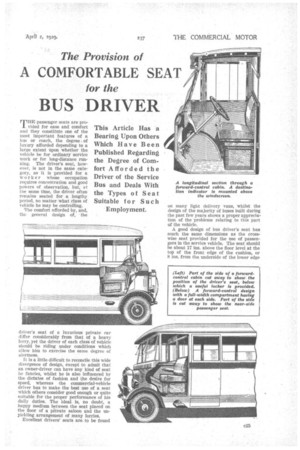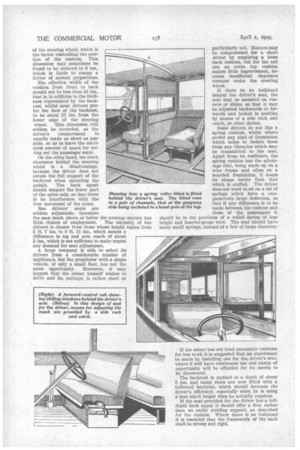The Provision of
Page 47

Page 48

Page 49

If you've noticed an error in this article please click here to report it so we can fix it.
A COMFORTABLE SEAT
for the
BUS DRIVER
T"passenger seats are provided for ease and comfort and they constitute one of the most important features of a bus or coach, the degree of luxury afforded depending to a large extent upon whether the vehicle he for ordinary service work or for long-distance running. The driver's seat, however, is not in the same category, as it is provided for a worker whose occupation requires concentration and good powers of observation, but, at the same time, the driver often remains seated for a lengthy period, no matter what class of vehicle he may be controlling.
The comfort afforded by, and, the general design of, the driver's seat of a luxurious private car differ considerably from that of a heavy lorry, yet the driver of each class of vehicle should be riding under conditions which allow him to exercise the same degree of alertness.
It is a little difficult to reconcile this wide divergence of design, except to admit that an owner-driver can have any kind of seat he fancies, whilst he is also influenced by the dictates of fashion and the desire for speed, whereas the commercial-vehicle driver has to make the best use of a seat which others consider good enough or quite suitable for the proper performance of his daily duties. The ideal is, no doubt, a happy medium between tile seat placed on the floor of a private saloon and the unyielding arrangement of many lorries.
Excellent drivers' seats are to be found on many light delivery vans, whilst the design of the majority of buses built during the past few years shows a proper appreciation of the problems relating to this part of the vehicle.
A good design of bus driver's seat has much the same dimensions as the crosswise seat provided for the use of passengers in the service vehicle. The seat should be about 17 ins, above the floor level at the top of the front edge of the cushion, or 8 ins, from the underside of the lower edge
of the steering wheel, which is the factor controlling the position of the cushion. This dimension may sometimes be found to be reduced to 6 ins., which is liable to cramp a driver of normal proportions.
The effective width of the cushion from front to back should not be less than 16 ins., that is, in addition to the thickness represented by the backrest, whilst most drivers prefer the face of the backrest, to be about 15 ins, from the lower edge of the steering wheel. This dimension will seldom be exceeded, as the driver's compartment is usually made as short as possible, so as to leave the maximum amount of space for setting out the passenger seats.
On the other hand, too much clearance behind the steering wheel is a disadvantage, because the driver does not obtain the full support of the backrest when operating the pedals. The back squab should support the lower part of the spine only, so that there is no interference with the free movement of the arms.
Bus drivers' seats are seldom adjustable, therefore the man much above or below the average stature has little chance of employment. The majority of bus drivers is chosen from those whose height varies from 5 ft. 7 ins. to 5 ft. 11 ins., which means a difference in leg and arm reach of about 2 ins., which is not sufficient to make urgent any demand for seat adjustment.
A large company is able to select its drivers from a considerable number of applicants, but the proprietor with a single vehicle, or only a small fleet, has not the same opportunity. Moreover, it may happen that the owner himself wishes to drive and he, perhaps, is rather short or
particularly tall. Matters may be compromised for a short driver by supplying a loose back cushion, but for the tall one an extra top cushion makes little improvement, because insufficient clearance remains under the steering wheel.
If there be no bulkhead behind the driver's seat, the seat may be mounted on runners or slides, so that it may be adjusted backwards or forwards and locked in position by means of a side rack and catch, or other device.
Some drivers do not like a spring cushion, whilst others prefer any kind of foundation which helps to isolate them from any vibration which may be transmitted to the seat. Apart from its resilience, the spring cushion has the advantage that, being made up on a wire frame and often on a boarded foundation, it keeps its shape better than that which is stuffed. The driver does not want to sit on a set of springs which have a comparatively. large deflection, so that if any difference is to be made between his cushion and those of the passengers it should be in the provision of a coiled spring of less height and heavier-gauge wire. The seat should have many small springs, instead of a few of large diameter.
If the owner has not tried pneumatic cushions for bus work it is suggested that an experiment be made by installing one for the driver's seat, where it will have continuous use and plenty of opportunity will be afforded for its merits to be discovered.
The backrest is padded to a depth of about 5 ins, and ninny seats are now fitted with a hollowed backrest, which should increase the driver's efficiency, especially when he is using a seat much longer than he actually requires.
If the seat provided for the driver has a fulldepth back squab it should offer a firm rather than an easily yielding support, as described for the cushion. Where there is no bulkhead it is essential that the framework of the back
• shall be strong and rigid.
This variety of seat also requires behind it a blind of some description for use at night, so that the driver is not confused by any lights which may be reflected in the windscreen: The support of the edge of the extended blind may easily be arranged on the off side, as a metal channel can be fastened to the body pillar in which the bottom lath of the blind is guided. On the other or gangway side a channel may be mounted, which is attached conveniently to an adjacent hand pole, but with, say, 3 ins, clearance between the channel and the pole, so that the latter may be easily grasped. The blind will be of the usual spring-roller pattern and from 3 ft. to 3 ft. 6 ins, wide, the roller being mounted at the same level as the tops of the windows. The chassis with forward control has the steering gear placed in a special position, in order that more space may be available for passenger seats. This, however, is not the only kind of special steering position, as the conventional type of chassis is sometimes made with the steering centre moved farther to the off side, thereby ensuring that no space is wasted on the righthand side of the driver. This loss will often occur with the usual position of steering, which is largely based on what is required for goods-carrying vehicles having drivers' cabs about 5 ft. wide, whereas the bus Is usually about 7 ft. wide.
The 2 ft. difference has a material effect in decreasing the seating space.












































































































